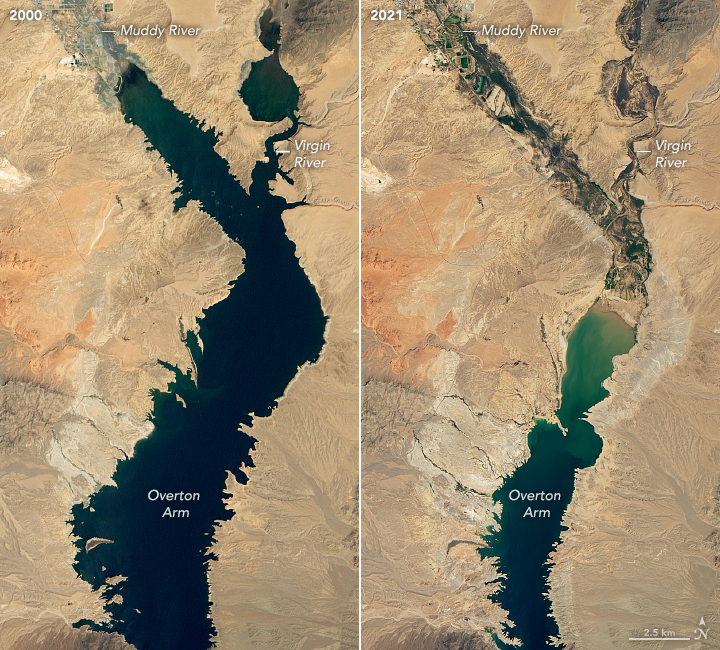The Colorado River is drying up
A comparison of Lake Mead, a water reservoir linked to the Colorado River between 2000 and 2021. (Courtesy of NASA)
Rivers carry water and nutrients all around the earth. They are absolutely essential for fresh drinking water, impacting people’s lives and nature. The Colorado river, for example, supplies water to around forty million people. However, scientists say that the river will be operating in what is known as a tier 2 shortage in January. This means that water usage in states in the Colorado river basin will plummet. Arizona is facing a twenty one percent reduction in water use, Nevada eight percent, and even neighboring Mexico by seven percent, according to CSG West.
The Colorado River Compact was signed 100 years ago between Arizona, Nevada, California, Colorado, New Mexico, Utah, and Wyoming. CNN’s chief climate correspondent Bill Weir says the lake has fallen from 95% full to around a quarter of what it used to be. This raises deep concerns for these states’ environments that rely greatly on this river for drinking water and agriculture. The states to the South and West are more near the lower basin of the river and will thus experience a greater cut in water.
There are plans being put into place by state legislators in order to combat the water shortage. In Nevada, people are being paid to remove lawns that are non-functional to help reduce water usage in general. California’s Governor Gavin Newsom has announced plans for capturing and storing rainwater as part of his plan for “ a new water strategy.” States are now negotiating a voluntary agreement to “slash 2-4 million acre-feet of Colorado River water usage” according to the U.S. Bureau of Reclamation. This historic drought in the West has also caused a toll on the lakes Mead and Powell, which are the largest water reservoirs in the country.
Lake Mead’s extremely sunken water level has not only provided a threat to water usage but also revealed things that have shocked scientists. It is a key water source to 25 million people and is now exposing old war ships and even human remains. The most shocking of it all is the reveal of rocks laced with volcanic ash, said to have rained down twelve million years ago due to explosive eruptions. This just goes to show how greatly compromised the water level. There is a bathtub shaped ring at the edge of the lake that spans the state border between Nevada and Arizona that is now almost empty. All this is calling for an increased demand for measures to be taken about climate change.
There are upstream reservoirs in the Colorado River Basin that are currently supplying Lake Powell with some extra water, but even that is now running out. Federal officials were hoping to have more time to plan for the likelihood that the Glen Canyon Dam would not have enough water to generate hydropower. Water managers are working to make sure the Lake stays above threshold but it is strikingly only 24 percent full currently.
Some drastic measures need to be taken to combat this climate crisis issue. Climate change is causing prolonged droughts that are sapping water from the West and the damages are going to be irreversible if it stays this way. Officials need to come up with a game plan that they must all agree on. The world needs to open their eyes to the fact that our rivers are, in fact, drying up. If there isn’t any measure taken to save these rivers, scientists fear the rivers will be dry in forty years time. And that is not too far away.


